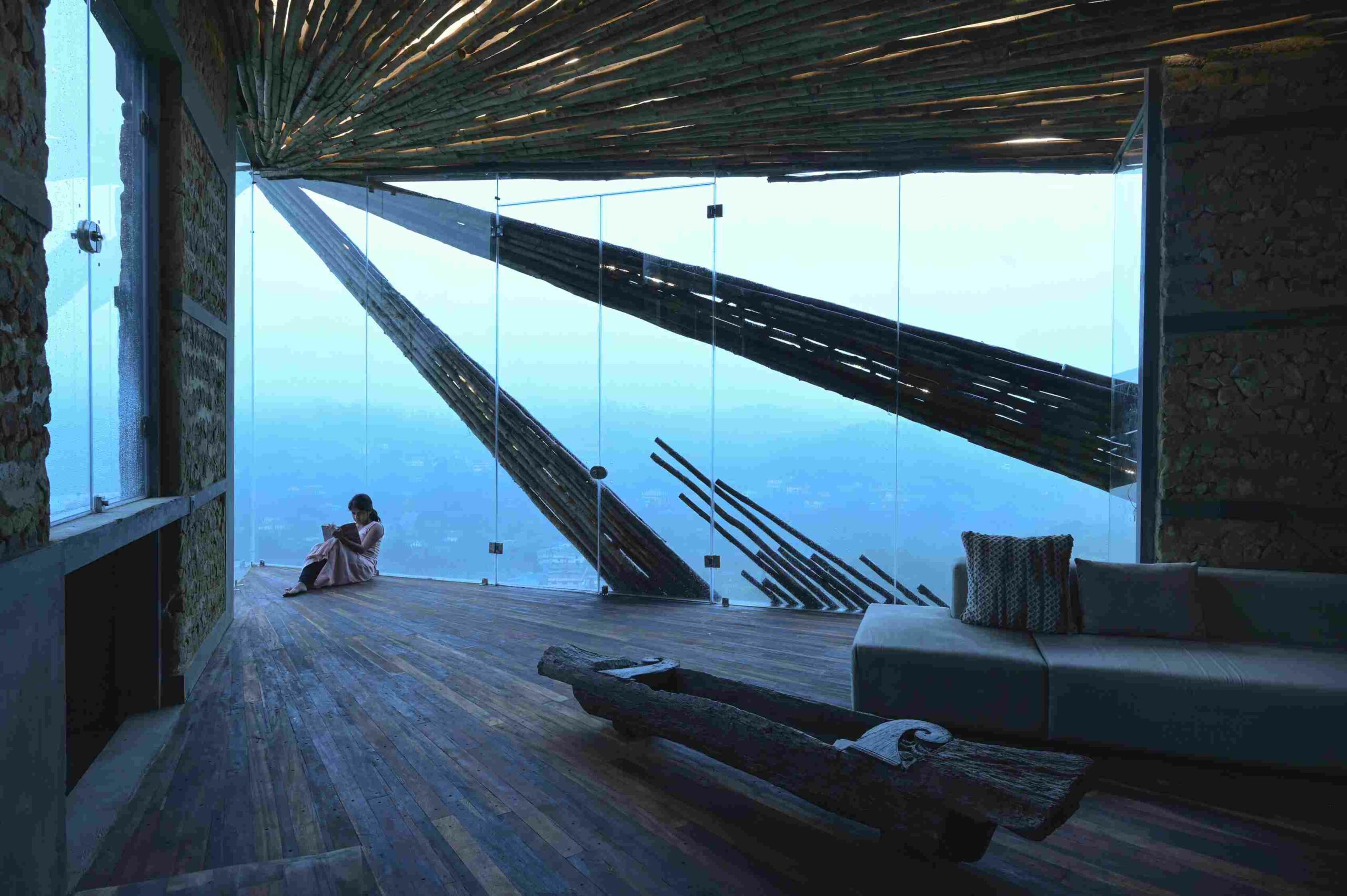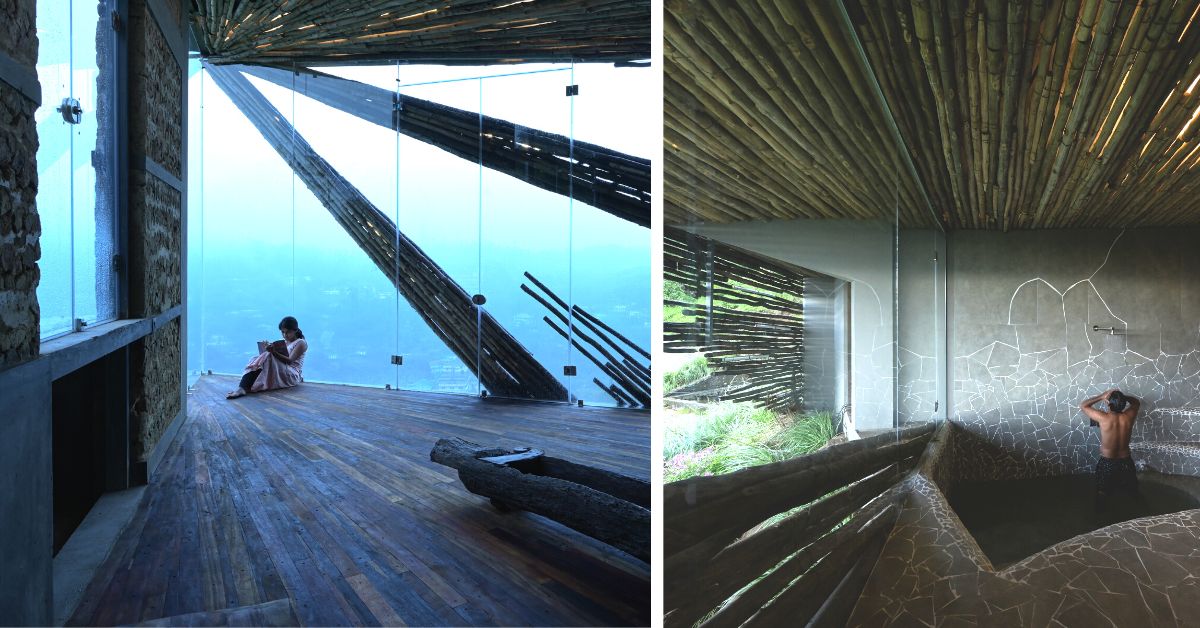Having once served as the summer residence for the kings of Travancore, the Peermedu Hills of Kerala haven’t lost their royalty quotient. The hill station in the Idukki district appears almost as if a real-life postcard, offering many tourists a breathtaking view that spans miles.
For anyone standing perched on top of one of the hills here, there’d be a glorious sight in front of them — cash crop plantations including tea, cardamom, and pepper; along with fauna in close quarters. To add to this cinematic experience, there’s the gush of the waterfalls, which have an almost musical symphony to them.
One morning in 2017, George Manu, an education professional who is based in Dubai, stood here. The moment never left his mind, and he decided he would build his dream home right here, nestled in these hills.
The Ledge House: Perched atop the Peermedu Hills

Today, George’s home has a prominent view of the surrounding tea plantations. Known as ‘The Ledge House’ due to its strategic location, the home is nothing short of a dream — with its regal framework, full-panel glass windows, and not to forget, the fact that it is burrowed into the mountain.
About why he chose the Peermedu Hills, he says, “It’s close to my hometown, the altitude is great, and the climate beautiful. What’s not to like?”
The home, he says, was meant to be a retirement house. “In Dubai, the summers are sweltering and so I envisioned the home as my respite.”
As George reached out to Vinu Daniel and his team for the design and construction of the house, he was clear in his intent. “I did not want something very huge, but at the same time, wanted the house to be spacious. I did not want nature around to be disturbed in any way. I found the hills beautiful as they were and wanted this to be retained.”
The team was more than excited at the prospect of this project. However, as Vinu Daniel says, having a home built on a mountaintop is not as storylike as it sounds.
“People are sceptical. Everyone wants the view. And so, someone might have the best view today, but in the next 10 years, with more homes coming up on that very mountain top, the view changes.”
Thus, they decided to follow a different approach when it came to The Ledge House — “To sustain the view, we built the home in a way that it stands on the edge of the cliff but is also burrowed into the mountain.”
The construction work began in 2018, and the 1900 sq ft home, comprising four rooms, was ready in 2019.
Built with recycled wood and no ACs
George says that the walls of the home are infused with the rocks in the hill, meaning there is a temperature balance, as the heat radiation is monitored.
“In summer, when one steps into the home from the outside heat, it almost feels like stepping into an air-conditioned suite. In winter, it is vice versa. I do not use any air conditioners or fans in the home.”
Vinu Daniel, the architect behind this regal project, says that temperature control was just one of the features of this home. The choice of materials used to build the home is even more interesting.
“The roof and wall are made of casuarina (an evergreen tree with a pine-like appearance).” He adds that like bamboo, the plant is not a common choice for construction, but popular in scaffolding.
“We treated the plant and then used the wood in the walls. Along with this, we also used recycled wood that was leftover from various construction projects and mills. We modelled the pieces and pieced the waste wood together to make the floor,” he adds.
The walls of the home have 5 per cent cement, and are based on a model called the ‘shutter debris wall’. “These walls are load bearing and made with soil debris, such as the stones produced during excavation and construction. It is then stabilised with cement,” Daniel adds.
While ‘ferrocement’ — a kind of concrete that uses less reinforcement — slabs have been used in the construction, no trees have been cut for completing The Ledge House.
“The idea was never to ruin nature in the process of building my dream,” says George, who says this idea took root in his childhood.
Summer vacations amid cardamom plantations
Recounting the inspiration behind wanting to have a home of this sort, George says, he was always a nature enthusiast.
“Since my growing up years, I have always loved the outdoors. Being brought up in Alleppey, Kerala, meant hours spent in the backwaters and days spent in the fields. This deepened the bond that I had with nature,” he tells The Better India.
To add to this, George’s vacations meant spending time at his grandfather’s cardamom plantations — 560 acres of land filled with spices of different kinds.
The weeks would fly by in a blur as George would spend what he calls “the most enjoyable time of his life” in the fields. But while he loved the openness that farming gave him, he made up his mind that when the time came, instead of going the usual route of cash crops, he’d do it differently.
“I did not want to make money from farming,” was his notion.
So, while George pursued his corporate ambitions in Dubai, he was always on the lookout to create a space of his own in his hometown Kerala. One that would be a haven where nature could bloom. And a space that he could return to for the holidays and when he’d finally retire from his work.
A sustainable project deep in the hills
Tracing back to his initial promise of not making money out of farming, George decided to invest in a food forest.
“There is an abundance of cash crops in and around the property, but commercialising farming was never my intent. Instead, I decided to plant fruit trees that would in time take care of themselves and be sustainable,” he explains.
The very year that George decided to build his dream home was when he planted the seeds of 120 different species of trees. Today, he says, the bio-diverse land is blooming with the fruits of mango, papaya and guava, along with 40 other fruits.
“In addition to this, I have a few crops that I grow for home use. These include cardamom and 160 pepper plants, 250 plantains, and in a two-acre area I have planted cattle grass.”
All the farming is done using cow dung that is procured from the two male cows that George has in the cow shed.
On the land, there is a setup for aquaponics. “The water from the tank, which has 400-odd fish, circulates and is used for irrigation. This has boosted the growth of the trees and other crops here.”
Ask George if he sometimes wishes he had commercialised the venture by selling the produce in nearby markets and he says, “Then I would be just another guy out there. I wanted to be different.”
As the sun sets over Peermedu and the hills are bathed in an orange glow, The Ledge House stands perched high and tall, a world in itself.
George sits back and gazes at the realisation of the dream he had five years ago and says, “Life is good.”
Edited by Pranita Bhat
If you found our stories insightful, informative, or even just enjoyable, we invite you to consider making a voluntary payment to support the work we do at The Better India. Your contribution helps us continue producing quality content that educates, inspires, and drives positive change.
Choose one of the payment options below for your contribution-
By paying for the stories you value, you directly contribute to sustaining our efforts focused on making a difference in the world. Together, let's ensure that impactful stories continue to be told and shared, enriching lives and communities alike.
Thank you for your support. Here are some frequently asked questions you might find helpful to know why you are contributing?

